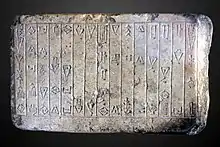Si'um
Si'um, also Siium, or Sium (𒋛𒅇𒌝, si-u-um, fl. late 3rd millennium BCE) was the 18th Gutian ruler of the Gutian Dynasty of Sumer mentioned on the "Sumerian King List" (SKL). According to the SKL: Si'um was the successor of Yarlaganda. Sium was the last king of the Gutians before Tirigan (likewise according to the SKL).[1]
| Si'um 𒋛𒅇𒌝 | |
|---|---|
| King of Sumer | |
 A Gutian inscription dated c. 2130 BCE. Lugalanatum prince of Umma ... built the E.GIDRU [Sceptre] Temple at Umma, buried his foundation deposit [and] regulated the orders. At that time, Siium was king of Gutum [or Qutum]." (Collection of the Louvre Museum.) | |
| Reign | fl. late 3rd millennium BCE |
| Predecessor | Yarlaganda |
| Successor | Tirigan |
| House | Gutian Dynasty of Sumer |
A tablet is known, dated to c. 2130 BCE, mentioning the allegiance of Lugalanatum prince of Umma to Sium, King of the Gutians.[2]
.jpg.webp) Name "Si-u-um" on the tablet, and corresponding standard Sumero-Akkadian cuneiform
Name "Si-u-um" on the tablet, and corresponding standard Sumero-Akkadian cuneiform.jpg.webp) Mention of the Gutian dynasty of Sumer in the tablet (last column: 𒄖𒋾𒌝𒆠, gu-ti-umKI)
Mention of the Gutian dynasty of Sumer in the tablet (last column: 𒄖𒋾𒌝𒆠, gu-ti-umKI)
| Preceded by Yarlaganda |
King of Sumer fl. late 3rd millennium BCE |
Succeeded by Tirigan |
References
- "However, the last three Royal names of the Guti dynasty are again not Semitic. The last two among them are Sium and Tirikkan (Jacobsen, 1939)." in Moisheson, Boris (2001). Armenoids in Prehistory. University Press of America. p. 141. ISBN 9780761817802.
- "From a text recently found at Jokha we also know that Lugal-annatum, patesi of Umma, Lugalanatum patesi of Umma, owed allegiance to Sium, King of Guti" Chisholm, Hugh (1913). The Britannica Year Book. Encyclopœdia Britannica Company, Limited. p. 259.
This article is issued from Wikipedia. The text is licensed under Creative Commons - Attribution - Sharealike. Additional terms may apply for the media files.